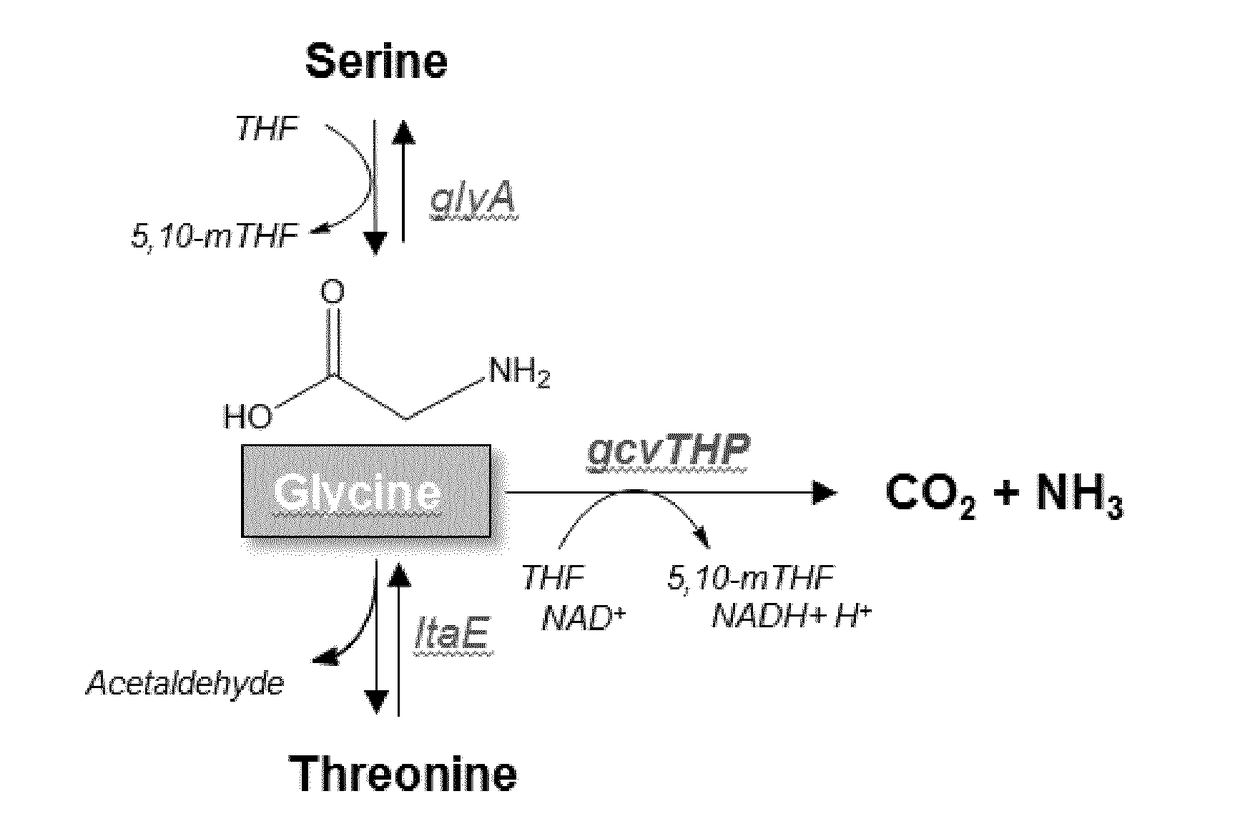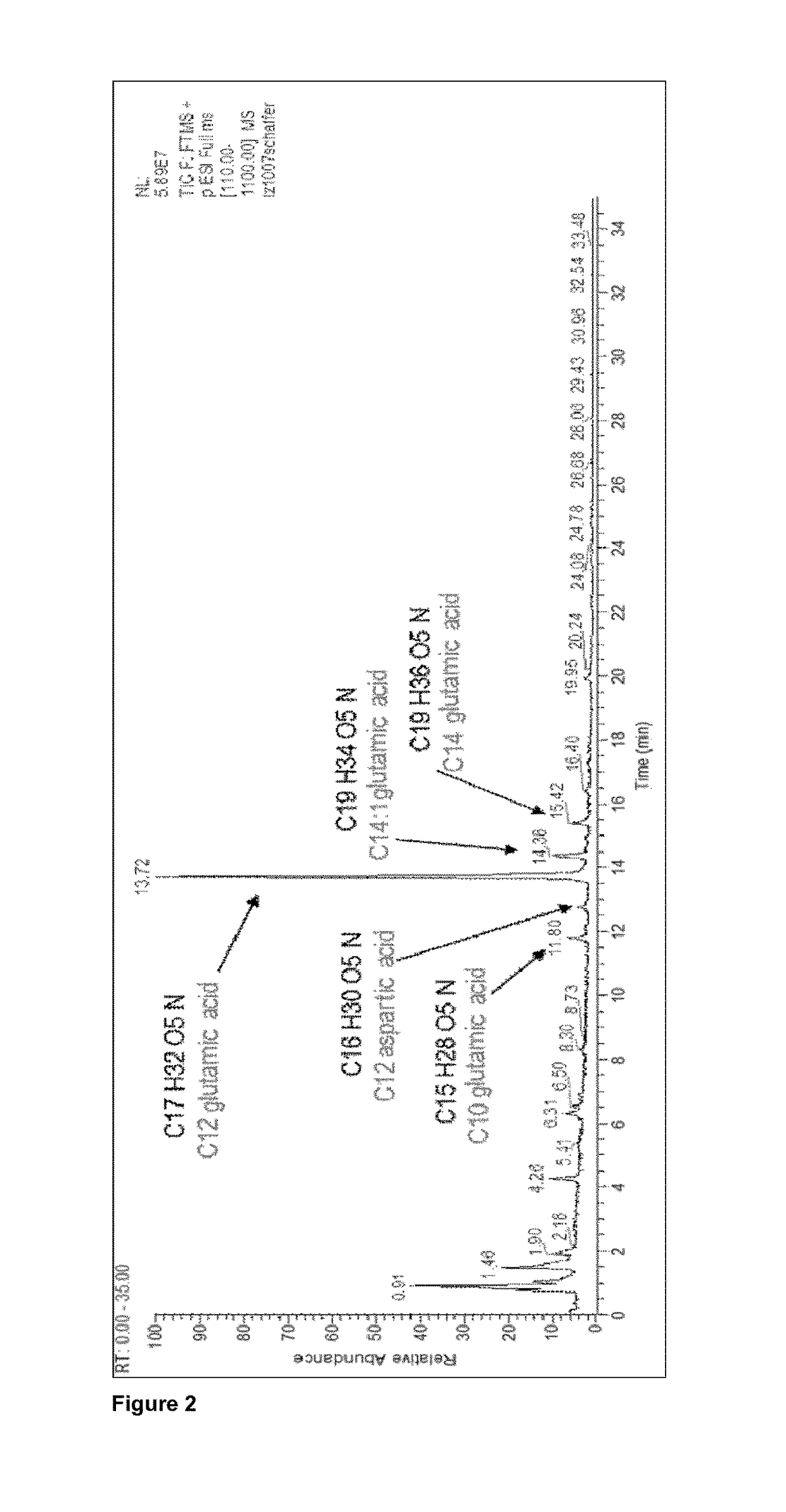Byosynthetic Production of Acyl Amino Acids
a technology byosynthetic production, which is applied in the direction of lyases, transferases, ligases, etc., can solve the problems of difficult control of composition and none of them is adequate for commercial large-scale production of acyl amino acids
- Summary
- Abstract
- Description
- Claims
- Application Information
AI Technical Summary
Benefits of technology
Problems solved by technology
Method used
Image
Examples
example 1
[0140]Generation of an Expression Vector for the Umbellularia californica Gene synUcTE
[0141]To generate an expression vector for the Umbellularia californica synUcTE gene (SEQ ID NO:1), which encodes the Umbellularia californica acyl CoA-thioesterase, this gene was codon-optimized for expression in Escherichia coli. The gene was synthesized together with a tac promoter (SEQ ID N0:2), and, simultaneously, one cleavage site was introduced upstream of the promoter and one cleavage site downstream of the terminator. The synthesized DNA fragment Ptac-synUcTE was digested with the restriction endonucleases BamHI and NotI and ligated into the correspondingly cut vector pJ294 (DNA2.0 Inc., Menlo Park, Calif., USA). The finished E. coli expression vector was referred to as pJ294[Ptac-synUcTE] (SEQ ID NO:3).
example 2
[0142]Generation of Vectors for Coexpression of Escherichia coli fadD with Either the Homo sapiens Genes hGLYAT3 and hGLYAT2
[0143]To generate vectors for the coexpression of the Homo sapiens genes hGLYAT2 (SEQ ID NO:4) or hGYLAT3 (SEQ ID NO:5), which encodes human glycine-N-acyltransferase, with Escherichia coli fadD (SEQ ID NO:6), which encodes the E. coli acyl-CoA synthetase, the genes hGLYAT2 and hGLYAT3 were codon-optimized for expression in Escherichia coli and synthesized. The synthesized DNA fragments were digested with the restriction endonucleases SacII and Eco47III and ligated into the correspondingly cut pCDF[atfA1_Ab(co_Ec)-fadD_Ec] (SEQ ID NO:7) with removal of the aftAl gene. The sequence segments which were additionally removed in this process were cosynthesized during gene synthesis. The vector is a pCDF derivative which already comprises a synthetic tac promoter (SEQ ID NO:2) and the Escherichia coli fadD gene. The resulting expression vectors were named pCDF{Ptac}[...
example 3
[0144]Generation of Vectors for the Coexpression of the Homo sapiens hGLYAT2, Escherichia coli fadD and Pseudomonas putida alkL Genes
[0145]To generate vectors for the coexpression of the hGLYAT2 genes with a modified Pseudomonas putida alkL gene, which encodes AlkL, an outer membrane protein that facilitates the import of hydrophobic substrates into a cell, the alkL gene (SEQ ID NO:10) was amplified together with the lacuv5 promoter (SEQ ID NO:11) from the plasmid pCDF[alkLmod1] (SEQ ID NO:12) by means of sequence-specific oligonucleotides. The PCR products were cleaved with the restriction endonucleases BamHI and NsiI and ligated into the correspondingly cleaved vector pCDF{Ptac}[hGLYAT2(co_Ec)-fadD_Ec] (SEQ ID NO:8). The correct insertion of the target genes was checked by restriction analysis and the authenticity of the introduced genes was verified by DNA sequencing. The resulting expression vector was named pCDF{Ptac}[hGLYAT2(co_Ec)-fadD_Ec]{Placuv5}[alkLmod1] (SEQ ID NO:13).
[0...
PUM
| Property | Measurement | Unit |
|---|---|---|
| Fraction | aaaaa | aaaaa |
| Degradation properties | aaaaa | aaaaa |
Abstract
Description
Claims
Application Information
 Login to View More
Login to View More - R&D
- Intellectual Property
- Life Sciences
- Materials
- Tech Scout
- Unparalleled Data Quality
- Higher Quality Content
- 60% Fewer Hallucinations
Browse by: Latest US Patents, China's latest patents, Technical Efficacy Thesaurus, Application Domain, Technology Topic, Popular Technical Reports.
© 2025 PatSnap. All rights reserved.Legal|Privacy policy|Modern Slavery Act Transparency Statement|Sitemap|About US| Contact US: help@patsnap.com



